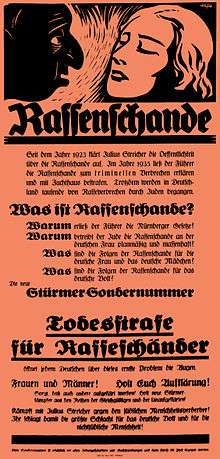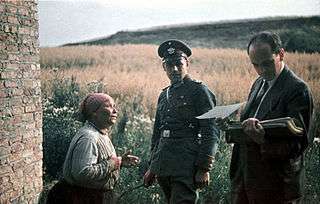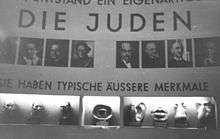Nazism and race
| Race |
|---|
| Genetics and differences |
| Society |
| Race and... |
| Related topics |
|
Nazism adopted and further developed several hypotheses concerning race. The Nazis claimed to scientifically measure a strict hierarchy of human race; the "master race" was said to be the purist stock of the Aryan race, which was narrowly defined by the Nazis as the Nordic race.
At the bottom of the Nazis' racial hierarchy were "parasitic" races (of non-"Aryan" origin) or "Untermenschen" ("sub-humans"), which were perceived to be dangerous to society. In Nazi literature, the term 'Untermensch' was applied to the Slavs, including Russians, Serbs, and ethnic Poles.[1] Nazi ideology viewed Slavs as an inferior non-Aryan group, who were fit only for extermination and enslavement.[2] About two million non-Jewish Poles were killed by Nazi Germany.[3][4] After the Slavs, lowest of all in the Nazi racial policy were Gypsies and finally Jews, who were both eventually deemed to be "Lebensunwertes Leben" ("Life unworthy of life") and to be exterminated during the Holocaust (see Raul Hilberg's description of the various phases of the Holocaust).[5]
Racialist ideology
Origins
It was the catastrophe of losing the First World War with its devastating economic consequences which set the stage for racism to take root as one means of apportioning blame for Germany's misfortune. The Nazis exploited this popular latent racism extensively in their propaganda.
Philosophers and other theoreticians participated in the elaboration of Nazi ideology. The relationship between Heidegger and Nazism has remained a controversial subject in the history of philosophy, even today. According to the philosopher Emmanuel Faye, Heidegger said of Spinoza that he was "ein Fremdkörper in der Philosophie", a "foreign body in philosophy" – Faye notes that Fremdkörper was a term which belonged to the Nazi glossary,[6][7] and not to classical German. However Heidegger did to a certain extent criticise racial science, particularly in his Nietzsche lectures, which reject biologism in general. While generally speaking even in Heidegger's most German nationalist and pro-Nazi works of the early 30s, such as his infamous Rectorial address there is a lack of any overtly racialised language. Thus it is problematic to connect Heidegger with any racial theory. Carl Schmitt elaborated a philosophy of law praising the Führerprinzip and the German people, while Alfred Baeumler instrumentalized Nietzsche's thought, in particular his concept of the "Will to Power", in an attempt to justify Nazism.
Ideology
Different Nazis offered a range of arguments—some pseudo-religious, others pseudoscientific—as to why the Aryan or Northern European man was racially superior to persons of other races. But the central dogma of Aryan superiority was espoused by officials throughout the party.
Richard Walther Darré, Reich Minister of Food and Agriculture from 1933 to 1942, popularized the expression "Blut und Boden" ("Blood and Soil"), one of the many terms of the Nazi glossary ideologically used to enforce popular racism in the German population. There were many academic and administrative scholars of race who all had somewhat divergent views about the social misconception of racism, including Alfred Rosenberg and Hans F. K. Günther [8]
Fischer and Lenz were appointed to senior positions overseeing the policy of racial hygiene. The Nazi state used such ideas about the differences between European races as part of their various discriminatory and coercive policies which culminated in the Holocaust. Ironically, in Grant's first edition of his popular book The Passing of the Great Race he classified Germans as being primarily Nordic, but in his second edition, published after the USA had entered WWI, he had re-classified the now enemy power as being dominated by "inferior" Alpines, a tradition evident in the work of Harvard Professor of Anthropology Carlton Coon's work, The Races of Europe.
Günther's work stated that the Germans are definitely not a fully Nordic people, and divided them into Western (Mediterranean), Nordic, Eastern (Alpine), East Baltic and Dinaric races. He also stated that European Jews belonged in certain proportion to the same races as Germans did, including the Nordic race.[9] Hitler himself was later to downplay the importance of Nordicism in public for this very reason. The simplistic tripartite model of Grant which divided Europeans into only Alpine, Mediterranean, and Nordic, Günther did not use, and erroneously placed most of the population of Hitler's Germany in the Alpine category, especially after the Anschluss. This has been used to downplay the Nordic presence in Germany.
J. Kaup led a movement opposed to Günther. Kaup took the view that a German nation, all of whose citizens belonged to a "German race" in a populationist sense, offered a more convenient sociotechnical tool than Günther's concept of an ideal Nordic type to which only a very few Germans could belong. Nazi legislation identifying the ethnic and "racial" affinities of the Jews reflects the populationist concept of race. Discrimination was not restricted to Jews who belonged to the "Semitic-Oriental-Armenoid" and/or "Nubian-African/Negroid" races, but was directed against all members of the Jewish ethnic population.[10]
The German Jewish journalist Kurt Caro (1905–1979) who emigrated to Paris in 1933 and served in the British army from 1943,[11] published a book under the pseudonym Manuel Humbert unmasking Hitler's Mein Kampf in which he stated the following racial composition of the Jewish population of Central Europe: 23.8% Lapponoid race, 21.5% Nordic race, 20.3% Armenoid race, 18.4% Mediterranean race, 16.0% Oriental race.[12]
By 1939 Hitler had abandoned Nordicist rhetoric in favour of the idea that the German people as a whole were united by distinct "spiritual" qualities. Nevertheless, Nazi eugenics policies continued to favor Nordics over Alpines and other racial groups, particularly during the war when decisions were being made about the incorporation of conquered peoples into the Reich. The Lebensborn program sought to extend the Nordic race.[13][14][15] In 1942 Hitler stated in private,
I shall have no peace of mind until I have planted a seed of Nordic blood wherever the population stand in need of regeneration. If at the time of the migrations, while the great racial currents were exercising their influence, our people received so varied a share of attributes, these latter blossomed to their full value only because of the presence of the Nordic racial nucleus.[16]
Hitler and Himmler planned to use the SS as the basis for the racial "regeneration" of Europe following the final victory of Nazism. The SS was to be a racial elite chosen on the basis of "pure" Nordic qualities.[17][18][19]
Addressing officers of the SS-Leibstandarte "Adolf Hitler" Himmler stated:
The ultimate aim for those 11 years during which I have been the Reichsfuehrer SS has been invariably the same: to create an order of good blood which is able to serve Germany; which unfailingly and without sparing itself can be made use of because the greatest losses can do no harm to the vitality of this order, the vitality of these men, because they will always be replaced; to create an order which will spread the idea of Nordic blood so far that we will attract all Nordic blood in the world, take away the blood from our adversaries, absorb it so that never again, looking at it from the viewpoint of grand policy, Nordic blood, in great quantities and to an extent worth mentioning, will fight against us.[20]
Propaganda and implementation of racial theories




Nazis developed an elaborate system of propaganda to diffuse these theories. Nazi architecture, for example, was used to create the "new order" and improve the "Aryan race." Sports were also seen by the Nazis as a way to "regenerate the race" by exposing supposedly inferior peoples, namely the Jews, as slovenly, sedentary and out-of-shape. The Hitler Youth, founded in 1922, had among its basic motivations the training of future "Aryan supermen" and future soldiers who would faithfully fight for the Third Reich.
Cinema was also used to promote racist theories, under the direction of Joseph Goebbels' Propagandaministerium. The German Hygiene Museum in Dresden diffused racial theories. A 1934 poster of the museum shows a man with distinctly African features and reads, "If this man had been sterilized there would not have been born ... 12 hereditarily diseased."(sic)[21] According to the current director Klaus Voegel, "The Hygiene Museum was not a criminal institute in the sense that people were killed here," but "it helped to shape the idea of which lives were worthy and which were worthless."[21]
Nazi racial theories soon translated into legislation, most notably with the 1935 Nuremberg Laws and the July 1933 Law for the Prevention of Hereditarily Diseased Offspring. The Aktion T4 euthanasia programme, in which the Kraft durch Freude (KdF, literally "Strength Through Joy") youth organisation participated, targeted people accused of representing a danger of "degeneration" towards the "Deutsche Volk." Under the race laws, sexual relations between Aryans (cf. Aryan certificate) and non-Aryans known as Rassenschande ("race defilement") became punishable by law.[22][23] To preserve the "racial purity" of the German blood, after the beginning of the war the Nazis extended the race defilement law to include all foreigners (non-Germans).[24]
Despite the laws against Rassenschande, allegations of rape against Jewish women during the Holocaust by Nazi soldiers have surfaced.[25]
The Nazi regime called for all German people wanting to be citizens of the Reich to produce proof of Aryan ancestry, certain exceptions were made when Hitler issued the "German Blood Certificate" for those people classified by the race laws to be of partial Aryan and Jewish ancestry.
During World War II, Germanization efforts were carried out in central and eastern Europe to cull those of "German blood" there. This started with the classification of people into the Volksliste. Those selected were either sent for Germanization, or killed to prevent "German blood" being used against the Nazis.[26] In regions of Poland, Poles either mass murdered or ethnically cleansed to make room for Baltic Germans[27] induced to emigrate after the pact with the USSR.[28] Efforts were made to identify people of German descent with Nordic traits from pre-war citizens of Poland, once chosen if the individual passed the screening process test of being considered "racially valuable" they were then abducted from their parents to be Germanized and then sent to Germany to be raised as Germans, those children who failed racist tests were used as test subjects in medical experiments or used as slaves in German industry.[29][30]
Western countries, such as France, were treated less roughly because they were viewed as racially superior to the "subhuman" Poles that were to be enslaved and exterminated, though not as good as full Germans; a complex of racial categories was boiled down by the average German to mean "East is bad and West is acceptable."[31] Still, extensive racial classification was practiced in France, for future uses.[32]
See also
- Anti-Russian sentiment
- Aryan certificate
- Hutu Power
- An Investigation of Global Policy with the Yamato Race as Nucleus
- "Life unworthy of life"
- Manifesto of Race
- Nazi crimes against the Polish nation
- Nazi eugenics
- State racism
- Übermensch
- World War II persecution of Serbs
References
- ↑ Rosenberg, Alfred (1933). Der Mythos des 20. Jahrhunderts (in German). Hoheneichen Verlag. p. 234.
- ↑ Mineau, André (2004). Operation Barbarossa: Ideology and Ethics Against Human Dignity. Amsterdam; New York: Rodopi. p. 180. ISBN 90-420-1633-7.
- ↑ Piotrowski, Tadeusz (2005). "Project InPosterum: Poland WWII Casualties". Retrieved 15 March 2007.
- ↑ Łuczak, Czesław (1994). "Szanse i trudności bilansu demograficznego Polski w latach 1939–1945". Dzieje Najnowsze (1994/2).
- ↑ Simone Gigliotti, Berel Lang. The Holocaust: A Reader. Malden, Massachusetts, USA; Oxford, England, UK; Carlton, Victoria, Australia: Blackwell Publishing, 2005. Pp. 14.
- ↑ Emmanuel Faye (2005). Heidegger, L'Introduction Du Nazisme Dans La Philosophie (in French). Albin Michel. ISBN 978-2-226-14252-8.
- ↑ Faye, Emmanuel; Watson, Alexis; Golsan, Richard Joseph (2006). "Nazi Foundations in Heidegger's Work". South Central Review. 23 (1): 55–66. doi:10.1353/scr.2006.0006.
- ↑ Burleigh, M. (1996) CONFRONTING THE NAZI PAST: New Debates on Modern German History. New York: St. Martin's Press. ISBN 0-312-16353-3. 199 pp.
- ↑ Hans F. K. Günther The Racial Elements of European History
- ↑ Wiercinski, Andrzej; Bielicki, Tadeusz (February 1962). "The Racial Analysis of Human Populations in Relation to Their Ethnogenesis". Current Anthropology. 3 (1): 2, 9–46. doi:10.1086/200244.
- ↑ "Kurt Caro". German Federal Archives. Retrieved 5 May 2008.
- ↑ Humbert, Manuel (1936). Hitler's "Mein Kampf". Dichtung und Wahrheit. Paris: Kurt Michael Caro. p. 139.
- ↑ Gumkowski, Janusz; Kazimierz Leszczynski. "Poland under Nazi Occupation". Archived from the original on 2012-05-27. Retrieved 19 July 2007.
- ↑ Crossland, David. "Nazi Program to breed Master race, Lebensborn Children Break Silence". Der Spiegel. Retrieved 20 July 2007.
- ↑ "Opening Statement of the Prosecution in the Einsatzgruppen Trial". Nuremberg Trial Documents. Retrieved 20 July 2007.
- ↑ Trevor-Roper, H.R.; Weinberg, Gerhard L. (1 December 2007). Hitler's Table Talk: 1941 - 1944. Enigma Books. p. 475. ISBN 978-1-929631-66-7.
- ↑ Hale, Christopher (2003). Himmler's Crusade. Bantam Press. pp. 74–87. ISBN 0-593-04952-7.
- ↑ Russell, Stuart (1999). Heinrich Himmler's Camelot. Kressman-Backmayer.
- ↑ Field, Geoffrey G. (1977). "Nordic Racism". Journal of the History of Ideas. University of Pennsylvania Press: 523.
- ↑ DOCUMENT 1918-PS "Nazi Conspiracy and Aggression" Check
|url=value (help). USGPO, Washington: University of North Carolina at Charlotte. 1946. pp. 553–572. Retrieved 19 July 2007. - 1 2 Rietschel, Matthias (9 October 2006). "Nazi racial purity exhibit opens in Germany". MSNBC. Dresden, Germany: The Associated Press. Retrieved 9 February 2010.
- ↑ Robert Proctor (1988). Racial Hygiene: Medicine Under the Nazis. Harvard University Press. p. 132. ISBN 978-0-674-74578-0.
- ↑ David Bankier; Israel Gutman (2009). Nazi Europe and the Final Solution. Berghahn Books. p. 99. ISBN 978-1-84545-410-4.
- ↑ Diemut Majer (2003). "Non-Germans" Under the Third Reich: The Nazi Judicial and Administrative System in Germany and Occupied Eastern Europe with Special Regard to Occupied Poland, 1939-1945. JHU Press. p. 180. ISBN 978-0-8018-6493-3.
- ↑ http://www.cnn.com/2011/WORLD/europe/06/24/holocaust.rape/
- ↑ Nazi Conspiracy & Aggression Volume I Chapter XIII Germanization & Spoliation
- ↑ Lynn H. Nicholas, Cruel World: The Children of Europe in the Nazi Web p. 213-4 ISBN 0-679-77663-X
- ↑ Lynn H. Nicholas, Cruel World: The Children of Europe in the Nazi Web p. 207-9 ISBN 0-679-77663-X
- ↑ Joseph W. Bendersky (11 July 2013). A Concise History of Nazi Germany. Rowman & Littlefield Publishers. p. 180. ISBN 978-1-4422-2270-0.
- ↑ Volker R. Berghahn, "Germans and Poles 1871–1945", in Germany and Eastern Europe: Cultural Identities and Cultural Differences. New York and Amsterdam: Rodopi, 1999.
- ↑ Lynn H. Nicholas, Cruel World: The Children of Europe in the Nazi Web p. 263 ISBN 0-679-77663-X
- ↑ Lynn H. Nicholas, Cruel World: The Children of Europe in the Nazi Web p. 278 ISBN 0-679-77663-X
Bibliography
- Biddiss, Michael D. 1970. Father of Racist Ideology: The Social and Political Thought of Count Gobineau. New York: Weybright and Talley.
- Ehrenreich, Eric. 2007 The Nazi Ancestral Proof: Genealogy, Racial Science, and the Final Solution. Bloomington, IN: Indiana University Press.
- Kühl, Stefan. 1994. The Nazi Connection: Eugenics, American Racism, and German National Socialism. New York, NY: Oxford University Press.
- Lombardo, Paul A. 2002. "‘The American Breed’: Nazi Eugenics and the Origins of the Pioneer Fund." Albany Law Review 65:743–830.
- Mintz, Frank P. 1985. The Liberty Lobby and the American Right: Race, Conspiracy, and Culture. Westport, CT: Greenwood.
- Poliakov, Leon. 1974. Aryan Myth: A History of Racist and Nationalist Ideas in Europe. New York, NY: Basic Books.
- Tucker, William. 2002. The Funding of Scientific Racism: Wickliffe Draper and the Pioneer Fund. Urbana, IL: University of Illinois Press.
